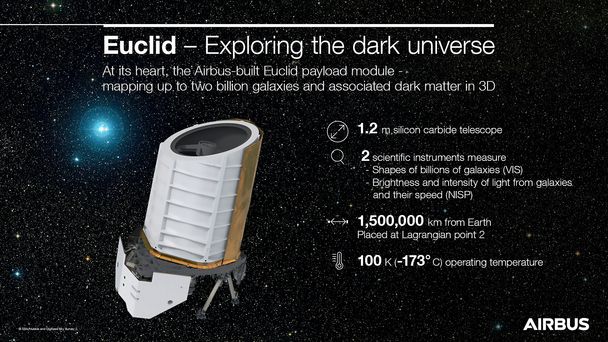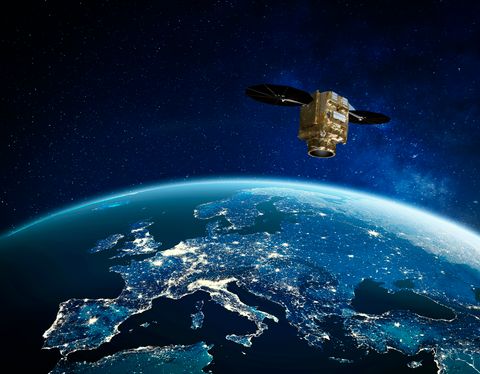Euclid, the space telescope aiming to unlock the secrets of the Universe

Even though life as we know it has a beginning, an existence and an end, this doesn't seem to be the case for the Universe. If the Big Bang theory positions its start 13.5 billion years ago, the hypothesis for the Universe’s limit are still uncertain and scientific research has shown that it continues to expand.
A new pioneering European space mission
ESA's Euclid spacecraft launch planned in a few days will mark the beginning of a fascinating mission to explore the composition and evolution of the Dark Universe. This invisible part of the cosmos makes up around 95% of the mass and energy of our Universe.
The Euclid telescope will allow scientists to create a 3D map of the Universe across space and time, revealing its expansion and structure over cosmic history. The mission will therefore improve knowledge about two of its mysterious components, dark matter and energy, as well as the role of gravity.

Euclid will scan across the night sky. The different shades of grey depict the area of the sky covered over one year during Euclid’s six-year survey.
Copyright: ESA. Acknowledgement: Work performed by ATG under contract for ESA.
Euclid will measure the shapes, position and distances of billions of galaxies out to ten billion light-years away and also the brightness and intensity of light from galaxies, across more than one third of the sky.
One of the most complex telescopes observing galaxies ten billion years old
Along with Thales Alenia Space, prime contractor for the whole satellite, Airbus plays a major role in this mission. The company was chosen by ESA to develop the payload module which includes two instruments (VIS and NISP) and a telescope.
Airbus has built an exceptionally sensitive telescope with a 1.2-metre-diameter mirror and a focal length of 25 metres. By comparison, the focal length on a standard camera is on average 50 mm. It will capture light of galaxies that are ten billion years old, originating from the early Universe and only now reaching us.
“The quality level of the images requested by the scientists is really high," explains Laurent Brouard, Euclid Airbus project leader. “To meet their expectations, the mirrors inside the telescope are critical components. To give you an idea, one of the mirrors has been polished for three years and all the mirrors are aligned with each other to the nearest micron.”
Once in space in a very cold environment, the material is essential to maintain the same optical quality as during the test phases. The telescope and the mirrors are made entirely of SIlicon Carbide (SiC), a ceramic for which Airbus is a world leading expert for space.
“SiC is lighter and has a better stiffness than metal, and it can be optically polished making it perfect for high performance mirrors. Moreover, thanks to its low thermal expansion and very high thermal conductivity, SiC ensures an excellent thermal stability for operations in space down to -170° Celsius. It has already been proven on ESA’s Herschel and Gaia space observatories, but also in many other Earth observation spacecraft,“ says Brouard.
One month after its launch, Euclid will head to the “Lagrange Point L2*” located 1.5 million kilometres from the Earth. There it will join Hershel, Gaia and the James Webb Space Telescope.

Why dark matter matters
Today we understand the ordinary matter which composes only 5% of the Universe and can take the form of different states: solid, liquid, gaseous and plasma. This matter has a mass that can be calculated and which exerts a gravitational force around it. However, 95% of the remaining matter is unknown to us but has a gravitational effect too. Scientists estimate that 70% could be made of dark energy and 25% of dark matter, which are both invisible to human eyes.
Dark matter is said to be dark because it does not emit, reflect or absorb light, which makes it very difficult to observe. The only evidence of its existence is the gravitational effect that it exerts on ordinary matter. Dark matter acts like a magnet holding galaxies together.
Galaxies spin much faster than one would expect from their visible mass, so they should not be able to stay together. Mass, and consequently additional gravity, are missing to keep them from hurtling through space. The missing element which could explain the additional gravity is dark matter which astrophysicists have been trying to detect and determine its nature.
Knowing more on dark matter will help to solve the missing mass issue and understand the composition of nearly 30% of the Universe, compared to 5% currently.

Copyright ESA (acknowledgement: work performed by ATG under contract to ESA)
The Universe’s expansion is accelerating
We have known since Edwin Hubble's discoveries that the galaxies are gradually moving away from each other. In 1998, a group of scientists made an amazing discovery, for which they later received a Nobel Prize, that the expansion of the Universe is accelerating instead of being constant. Nevertheless the reason is still unknown.
Astrophysicists think that a new form of energy, called “dark energy”, could behave as a repulsive force that accelerates the expansion. This new source could counterbalance the effects of gravitational attraction, or even reverse them.
With the instruments’ measurements, the position of the galaxies and their distance, it will be possible to establish the most precise 3D map of the Universe ever made. With this map, scientists will be able to look into the history of the creation of the Universe, learn more about the origin of its expansion and understand how dark matter affects gravity. These discoveries could unlock one of the most compelling challenges of cosmology and fundamental physics today.
Euclid in a nutshell
Euclid is the result of international collaboration, with a consortium composed of more than 1,500 scientists from 300 laboratories and institutes in 21 different countries.
Satellite : 4.7 m tall, 3.7 m in diameter
Masse in orbit: 2 tonnes (800 kg for the payload module)
Telescope: 1.2-metre telescope, focal length of 25 metres
The 2 instruments:
- VISible-wavelength camera (VIS) will measure the shape of billions of galaxies.
- Near-Infrared Spectrometer and Photometer (NISP) will measure brightness and intensity of light from galaxies and their speed with the redshift effect

The light coming from distant galaxies will undergo modifications during its journey because of dark matter attraction. Indeed, instead of being a circular dot, the light will be twisted in an ellipse shape. The purpose of the telescope is to measure this ellipticity with the VIS instrument to derive a dark matter map. © Airbus
*The five Lagrange points are positioned in space where objects sent there tend to remain in position. Lagrangian points are locations in space where gravitational forces of two bodies like the Sun and Earth balance each other and create gravitational ‘plateaus’ where objects can move with them. L2 is selected for Euclid because it is not disturbed by the Earth, like all Lagrange points, and away from sun compared to L1

Copyright: ESA/Euclid/Euclid Consortium/NASA. Background galaxies: NASA, ESA, and S. Beckwith (STScI) and the HUDF Team



